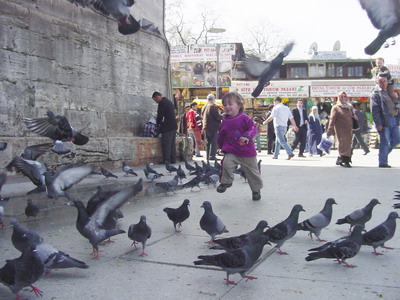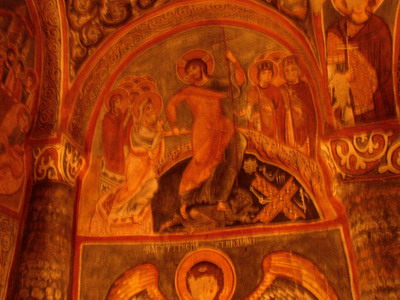For us as Israelis a visit to Turkey was not just a visit to another Middle Eastern country but an exploration of the Land of Israel's distant past. When we gazed at the Aya Sofya church (now a museum) built by Justinian in the 500's we recalled echoes of his building projects in the Holy Land such as the Cardo in the Old City of Jerusalem. Suleiman the Magnificent, who built the Suleymaniye Camii (mosque), the largest mosque in Istanbul, had the Dome of the Rock retiled with Iznik tiles. His finest architect Sinan, who built the Sulemanye bath house, was responsible for the walls we see today surrounding the Old City of Jerusalem. The Crusaders rampaged the city on their way to freeing Jerusalem from the infidels. Ben Gurion studied here.
Istanbul came as a surprise. As we. Eitan, Moran, Maayan and I, left the airport the roadsides were full of planted tulips. "What a nice welcome to Turkey" we remarked. Only later did we discover that Istanbul had been planted with some 3 million tulips, petunias, and hyacinths in a range of colours. The city was very clean and besides the people pestering us to eat in their restaurant, the rest were extremely friendly. The skyline of Istanbul is a constant delight – huge domed churches and mosques with their multiple minarets are all over the city. Istanbul which is purported to have 12 million people (but others estimate it as at least 15 million) is huge. We think we saw most of the city's inhabitants when we visited the pedestrian mall by Taksim square and observed a river of people filling the streets. Rahmi, Eitan's friend from the bridge world took us there to eat meze and talked passionately about Ataturk, the founder of the modern secular Turkish republic. We joined Rahmi and bridge friends Fahir and Julia another memorable evening when they took us to a superb fish restaurant. It is surprising that we can remember anything about the meal after the numerous bottles of Efe Raki (the local arak) that we downed with water first and then ice.
We had forgotten what it was like to travel with a young child. We
juggled
our time between things that Mayan liked to do and things that
interested
us.
He liked to:
 * best of all though was chasing pigeons in front of the Yeni mosque
* best of all though was chasing pigeons in front of the Yeni mosque
All this was very tiring for Sabi Eitan
Our interests converged while eating either in the market or at a restaurant or over a fish dinner
We, on the other hand delighted in the domed Blue Mosque and the impressive Byzantine cistern built by Justinian.
Topkapi and the Suleymaniye mosque
Arguing with the shoe shiner after he tried to rip me off
After Moran and Maayan flew back home we flew to Cappadocia. I took
the welcome sheet from the shuttle service and waited for Eitan to come
back from changing money.
The hour's drive to Urgup was well rewarded when we saw our hotel.
Cappadocia
is formed from soft 'tufa', yellowish volcanic ash spewed out by three
ancient volcanoes. Water and wind have eroded this tufa into weird
shapes
that are a fitting background for a fanciful and imaginative
illustrator
of children's books. For centuries people have carved their living
quarters
within these strange shapes. Happily our hotel Yunak Evleri was part of
these formations. Although some rooms were in caves in the hillside, in
our room only the bathroom was a cave while our high vaulted room was
made
from carved stone. Lying in bed and listening to classical music (no TV
in the rooms) with tall tapers flickering in the dark was incredibly
romantic.
The sprawling hotel is situated in a once active Greek village; a
cobbled
road ran through the hotel complex, dividing the reception, computer
room
and music room from the dining room. To get to our room you had to walk
down the street and enter a locked courtyard. Our room was in a complex
arrangement of rooms one next to the other, one on top of each other,
stairs
leading down and other stairs leading up. In a word "delightful."
We wandered around the open air museum of Zelve with its many caves and churches dating back about 800 years. Signs of eroded and collapsed cliffs were everywhere.
At the Goreme open-air museum we explored the myriad cave churches
with
the interesting frescoes from the Byzantine period. A theme unknown to
us was Jesus, after being victorious over Satan and death holding
Abraham
by the hand with Sarah behind and leading them together with David and
Solomon to heaven. Although we are used to pillars and arches
being
built, this photo shows how the church was carved out of the rock in
one
piece. After all this touring this table was not satisfying and
we
broke for lunch.

The next day we visited Kaymakli. The surface village is very drab
and uninteresting so we were unprepared for the underground city; a
huge
complex of inter-leading caves at different levels carved deeper and
deeper
into the tuff. The caves served as living quarters, storage rooms,
winepresses
and security rooms – note rolling stone. About 1700 years ago,
the
people lived above ground and descended into the caves when threatened
by an enemy. There were holes everywhere to try and trap unwanted
visitors.
We ended the day with a visit to a caravanserai where we saw a dervish ritual unfold. Slowly and in strict order the dancers and the orchestra entered the dimly lit hall and bowed to all sides. The voice of the hafiz who began by singing verses from the Koran was mesmerizing; it resonated like an instrument. Each piece of clothing they wear is symbolic, - the turbans their tombstones while the black cloaks are their tombs. After a long while they removed their cloaks and walked around the stage and started to whirl. Their white dresses, symbolizing their shrouds, billowed around them. It was magical. We felt it was a real privilege to experience what we saw there.
Back in Istanbul we spent our final night at Taksim square at a
sidewalk
fish restaurant, glad to have the chance to eat and watch the throngs
of
people go by. I enjoyed my last order of stuffed vineleaves and rice
pudding
and waddled back to our hotel.